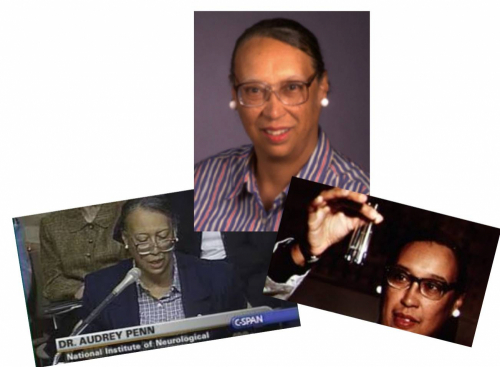Audrey S. Penn Biography
“If you are interested in science and medicine, then do it. It’s not going to be easy. But there is a lot of exciting research out there to be done, with many opportunities in all areas of science and medicine. You just have to get out there and learn about it.”
Dr. Audrey S. Penn

Audrey Shields Penn (born in 1934) is an American neurologist and emeritus professor. Her major area of research was in myasthenia gravis. Penn was elected President of the American Neurological Association in 1994. She was deputy director of the National Institute of Neurological Disorders and Stroke (NINDS), and is the first Black woman to serve as an (acting) director of an Institute of the National Institutes of Health.
A native of New York City, after high school she attended Swarthmore College in Swarthmore, Pa., where she majored in chemistry and received her B.A. in 1956. But she found she wanted a career that gave her more human contact. “I realized that chemistry didn’t have as much to do with people as I wanted,” says Penn. “So I applied to medical school.” Penn, a Black woman, began medical school at a time when few women or minorities became doctors. “My medical school class was only 10 percent female, and there were only one or two other minorities,” says Penn. “But I was fortunate. There were so few people like me, I didn’t get much flak.”
Penn gained her medical degree from Columbia University in New York in 1960, interning at the Bronx Municipal Hospital Center, and completed her neurology residency at Columbia University. She chose neurology, she said, “because there was so much wonderful information to learn about the brain and everything connected to it.”
At the University of Pennsylvania, Penn pursued postdoctoral study and research into the biochemistry of muscle diseases, especially myasthenia gravis, and investigated how certain drugs, for example pencillamine, might precipitate autoimmune diseases. She was an NINDS special fellow for postgraduate training in the biochemistry of muscle proteins implicated in muscle diseases. This later evolved into work on the acetylcholine receptor, the target protein in myasthenia gravis.
In 1970, she became the Black member of the Swarthmore College Board of Managers, and a member of the Council of the Education of Women at Yale. In 1972, she was promoted to associate professor of neurology at the University of Pennsylvania, then in 1982, Penn to professor of neurology, in the College of Physicians and Surgeons at Columbia University. She practiced as a neurologist at Columbia-Presbyterian Medical Center.
In 1989, Penn was elected second vice president of the American Neurological Association, then first vice president in 1990, and president for 1994. In this role she served as an important role model for many women physician-scientists. Eva Feldman, another prominent ANA president said “In brief, she told me, in so many words, I had an opportunity to change the ANA and increase its “voice.” I know I speak for all women of the ANA to say Audrey was and is a role model, mentor and has always had an open “door” and good counsel.”
Penn was also appointed as a member of the council of the NINDS. In 1995, she was recruited by the director Zach Hall to the position of deputy director of the Institute, which oversees intramural research and training, and extramural grants. She described her role: “My job goes all the way from making policy regarding finding the causes of neurological disorders, to training new neurologists and scientists, to dealing with patients and the general public,” she says. “We try to look down the road and make predictions about what will work in solving the problems of people with neurological disorders.”
Penn also became the first Black woman to serve as a director of an institute of the NIH, acting in that capacity for NINDS from January to July in 1998, and then from February 2001 to August 2003. After 10 years, in 2007, Penn retired from her position as deputy director, and moved to the Institute’s Office of Minority Health and Research, with the role of senior advisor to the Institute’s director. A symposium on myasthenia gravis was held in her honor at NINDS in 2007.
In several of the positions she held, Penn was the first Black or the first woman. She was a member of several professional organizations, and served as chair of the review panel for medical student fellowships at the Howard Hughes Medical Institute (HHMI).
